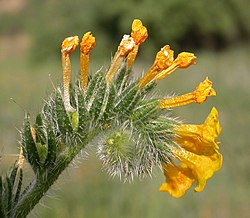| Amsinckia menziesii | |
|---|---|
 | |
| Scientific classification | |
| Kingdom: | Plantae |
| Clade: | Tracheophytes |
| Clade: | Angiosperms |
| Clade: | Eudicots |
| Clade: | Asterids |
| Order: | Boraginales |
| Family: | Boraginaceae |
| Genus: | Amsinckia |
| Species: | A. menziesii |
| Binomial name | |
| Amsinckia menziesii | |
| Synonyms [1] | |
| |
Amsinckia menziesii is a species of flowering plant in the family Boraginaceae, the borage or forget-me-not family. [1] [2]

